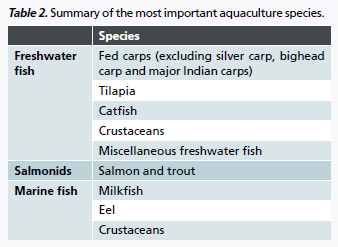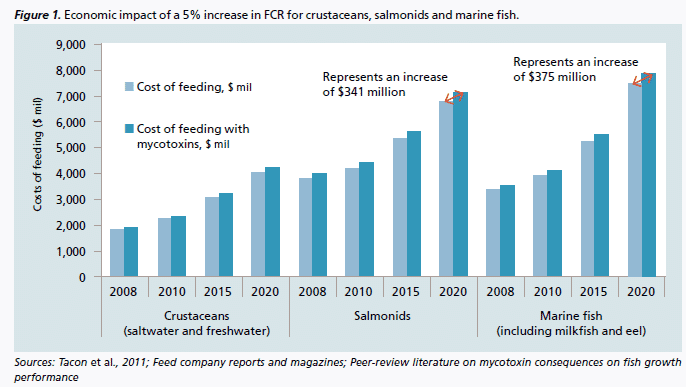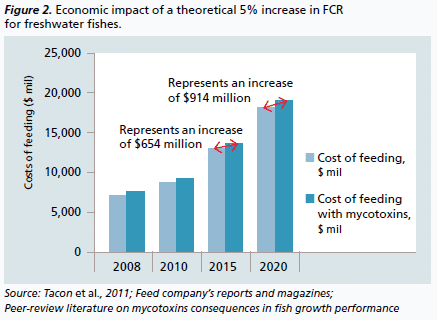Mycotoxins and their economic impact on aquaculture. Over the past years, aquaculture has moved away from dependence on fishmeal as the main protein source, with increasing reliance on plant protein sources. What does this mean for mycotoxin exposure in aquatic animals?
With fishmeal and oil becoming increasingly expensive, the inclusion of terrestrial plant-based proteins in commercial aquaculture feeds has gained widespread acceptance. Even feeds for carnivore species are now formulated to contain more than 50-70% of plant-derived matter. The most common plant feedstuffs used in aquafeeds are soybean meal, canola, corn, cottonseed, peas/lupins, rice bran, cassava and wheat.
A common problem that arises from the use of plant ingredients is the presence of mycotoxins—toxic secondary metabolites produced by filamentous fungi which frequently contaminate agricultural commodities.
The Council for Agricultural Sciences and Technology (CAST) in 2003 estimated that 25% of the world's crop production was contaminated with mycotoxins; the Biomin Mycotoxin Survey, however, estimates that this contamination rate is much higher. With more plant-derived materials used in commercial fish formulations, the risk of mycotoxin exposure increases, affecting fish growth performance as well as product quality.
These toxins are mainly produced under warm and moist conditions typical of the tropical and subtropical countries where most aquaculture is practiced. Temperature resistant, mycotoxins are not destroyed under the heat and pressure of pelleting and extrusion.
The main five
In the annual Biomin Mycotoxin Survey for 2013, a higher number of samples tested were related to ingredients intended for the aquaculture industry. Such samples included corn, corn DDGS, soybean meal, wheat, wheat bran, rice bran, cassava and cottonseed. In addition, a specific survey for aquafeeds (fish/shrimp) from the Asian region was included.
The five most common mycotoxins found worldwide— aflatoxins (Afla), zearalenone (ZEN), deoxynivalenol (DON), fumonisins (FUM) and ochratoxin A (OTA)—were analysed in all of the samples.
Out of a total of 43 finished aquafeed samples collected from the Asian region, 77% were found to be co-contaminated with more than one mycotoxin. The highest incidence was observed for ZEN, as 63% of all finished feed samples contained this estrogen-like substance. Average Afla concentrations were also quite high at 37 ppb, with some samples showing values above 100 ppb.
Looking at the level of contamination in major ingredients, corn samples contained the highest average and maximum concentrations of ZEN among all samples. As expected, DON and FUM were the most frequently found mycotoxins in corn with a prevalence of 73% and 63%, respectively.
The highest DON, FUM and OTA average values were observed in corn DDGS, as mycotoxin concentrations are known to increase after the distillation of corn for bio-ethanol production. The highest maximum FUM was observed in corn DDGS at 26,828 ppb.
DON is the most common mycotoxin found in wheat samples with an incidence of 64%. The highest average DON concentration was detected in wheat bran samples (2,111 ppb) which is twice the level found in heat samples. Compared to wheat bran, rice bran samples contained higher average Afla (16 ppb) and ZEN (105 ppb).
The concentration of mycotoxins in soybean meal was relatively low compared to other cereals. Also the incidence of mycotoxins in cassava is relatively low. Cottonseed samples showed a high prevalence of Afla (57%). The highest Afla values were also determined in cottonseed.
Mycotoxin impact on FCR
The biological effects of mycotoxins in aquatic species are thought to be directly linked to their concentration in the feed and to age and species. In aquaculture production, mycotoxins may, among other factors, influence growth performance and feed efficiency.
According to Tacon et al. (2011) the projected increase in aquaculture production until 2020 takes into account the increase in feeds used by different aquaculture species and improvements in FCR during this time period, as technology improves overall. This was done for the more representative aquaculture species (Table 2).
The authors’ projected the theoretical economic losses due to the presence of mycotoxins in aquafeeds. These losses were calculated plus an average 5% increase in FCR (taking into account the existing literature on mycotoxins’ impact on fish growth performance) and feeding costs (average values obtained from feed company reports and magazines) (Figures 1 and 2).
Taking the example of catfish production (Table 3), in 2020, it is expected that 80% of total production will utilize aquafeeds, with a total feed cost of $5.0 billion. Based on this production increase and a 5% increase in FCR, total feed costs due to mycotoxins contaminations can increase to $5.2 billion; that is, $250 million in extra costs are required to produce the same quantity of fish.
Further challenges
This simulation does not take into account the replacement of fishmeal on aquaculture diets. It is predicted that after 2015, catfish diets will not include fishmeal anymore, which will probably be replaced by plant proteins. Thus, there is a higher probability that catfish diets will be contaminated with mycotoxins. Even with a conservative 5% increase in FCR, the economic losses are highly significant. Another important factor indirectly related to an increase in FCR, carbon footprint was not taken into account in this simple simulation, but will nonetheless have economic and social consequences. The ingestion of mycotoxins decreases overall performance which may ultimately result in economic losses. Preventing mycotoxin-related diseases in the first place is surely more cost effective than treating ill animals. Mycotoxin risk management is therefore crucial in order to eliminate the effect of fungal toxins.
July 2014






